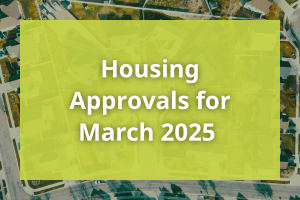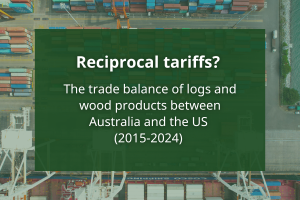The following update has been supplied by IndustryEdge from its online platform, Wood Market Edge online. All the data used and referred to here is available for download by IndustryEdge subscribers and is part of the most timely and comprehensive data and information service available in Australia.
![]()
Learn more about Wood Market Edge online here.
Australia’s monthly imports and annual apparent consumption of sawn softwood both hit new records in March 2022, as the forecast peak in demand was reached and met by supply. Imports lifted 28% on the prior month to reach the new record of 115.5 km3, but that moment in time was eclipsed by aggregate apparent consumption climbing 9.7% year-ended March to a new record of 3.849 million m3.
Because local sales are near their peak and softened marginally year-ended March (see the previous item in this edition of Statistics Count), annual imports necessarily had to rise for a strong new consumption record to be achieved. Imports lifted a very large 53% year-ended March, to total 802.6 km3. While that is short of record territory, as the chart here shows, continued strength in imports could see the 919.9 km3 record (year-ended December 2018) be breached in the second half of 2022.
Australian Imports of Sawn Softwood: Jan ’17 – Mar ’22 (‘000 m3)

Source: ABS and IndustryEdge
While there is a chance the record could be broken, stabilisation of demand and the turmoil in the shipping and freight sectors could see any result over coming months, especially if the extremely long delivery delays continue.
Continual increases in imports were inevitably necessary after demand was so super-heated. While total imports remain below their peak, as the second chart shows, year-ended March saw a very rapid increase in imports.
Equally important is that although the peak import proportion recorded here was year-ended March 2019 (22.8%), the record was reached way back in 2012 (24.0%). Again, though imports were proportionally below that over the last year, they lifted to 20.4% of total supply, coming from way down at 14.7% for the year prior.
Australian Sawn Softwood Supply Provenance: YE March 2017 – 2022 (‘000 m3 and %)

Source: FWPA, ABS and IndustryEdge
The supply provenance data feeds directly into analysis of apparent consumption. Here again, we can observe Australia reaching new records in recent months, on an annualised basis. At 3.849 million m3, consumption year-ended March was just 36,000 m3 higher than the previous annual peak, recorded in October 2018. The simple chart below demonstrates the central point here: without significant import supply, Australian consumption of sawn softwood would be dramatically curtailed.
Annual Apparent Consumption of Sawn Softwood: Jan ’12 – Mar ’22 (‘000 m3)

Source: FWPA, ABS and IndustryEdge
It may be good news that supply was able to leap to meet demand in the recent, large and rapid escalation, but the resilience of the supply chain has been sorely tested. It is still operating under challenges, not least of which is the extent to which prices have risen. The next item in this edition will address the weighted average prices for local products, but below, the average prices of major structural products are displayed.
These aggregations of a range of products demonstrate the general price trend has been upwards, but that for the Treated Structural Dressed grades (equivalent to local sales of Treated Structural <120mm and >120mm), the price rises have been little short of remarkable.
Selected Sawn Structural Timber Import Prices: Jan ’17 – Mar ’22 (m3 & AUDFob/m3)

Source: ABS and IndustryEdge
The weighted average import price for the dominant groupings of Treated Structural Dressed products peaked in June 2021 at AUDFob803/m3. Though it has subsequently fallen back to record AUDFob714/m3 in March 2022, compared to a year earlier, the average price of this group of products is a massive 59.6% higher. For the Non-Treated Structural grades, the March 2022 average import price of AUDFob1,009/m3 was a far more modest 10.3% higher than a year earlier.
There should be no surprise in huge price increases. Relative scarcity, in the context of hyper-stimulated demand, has been a global phenomenon, not a local curiosity. That has fuelled price increases the data suggests has been overdue for at least the last few years. The rationale for lower prices in the future, for these major products is difficult to make, in both local and international contexts.
The local context is that for all that demand is slowing, the long pipeline of work means there is plenty of demand left to meet, for the next year and more. Equally significant, the likely weakening of the Australian dollar against the US dollar will add to cost pressures.
The latest forecast of demand for sawn structural softwood shows a softening through to around September this year. After that, leaving aside the seasonal declines, the new demand forecast shows around 200,000 m3 per month of structural demand alone.
This chart from Wood Market Edge online shows the decline in demand, but also the recent consumption experience. As forecast new demand declines progressively, consumption is likely to be above demand. That occurred in March as extra supply began the long process of soaking up the huge demand in the pipeline.

What can easily be missed in this chart is that the only way the additional demand of the current boom can be absorbed is by imports remaining at elevated levels. That is required, but there is by no means a guarantee that imported supply will always be available, at any price, even these recent higher prices.
If we add to that the decision of Bunnings (and others) to drop Russian supplied wood products altogether, the challenges grow. Australia has for some time been importing relatively large amounts of wood products from Russia, even up to March, as the data below shows.

As many will be aware, the majority of these imports from Russia are engineered wood products, like Laminated Veneer Lumber. Read further analysis here.
As the Russian volume tapers off in coming months, Australia’s supply challenge will compound.
That is unlikely to be a short-term issue.



